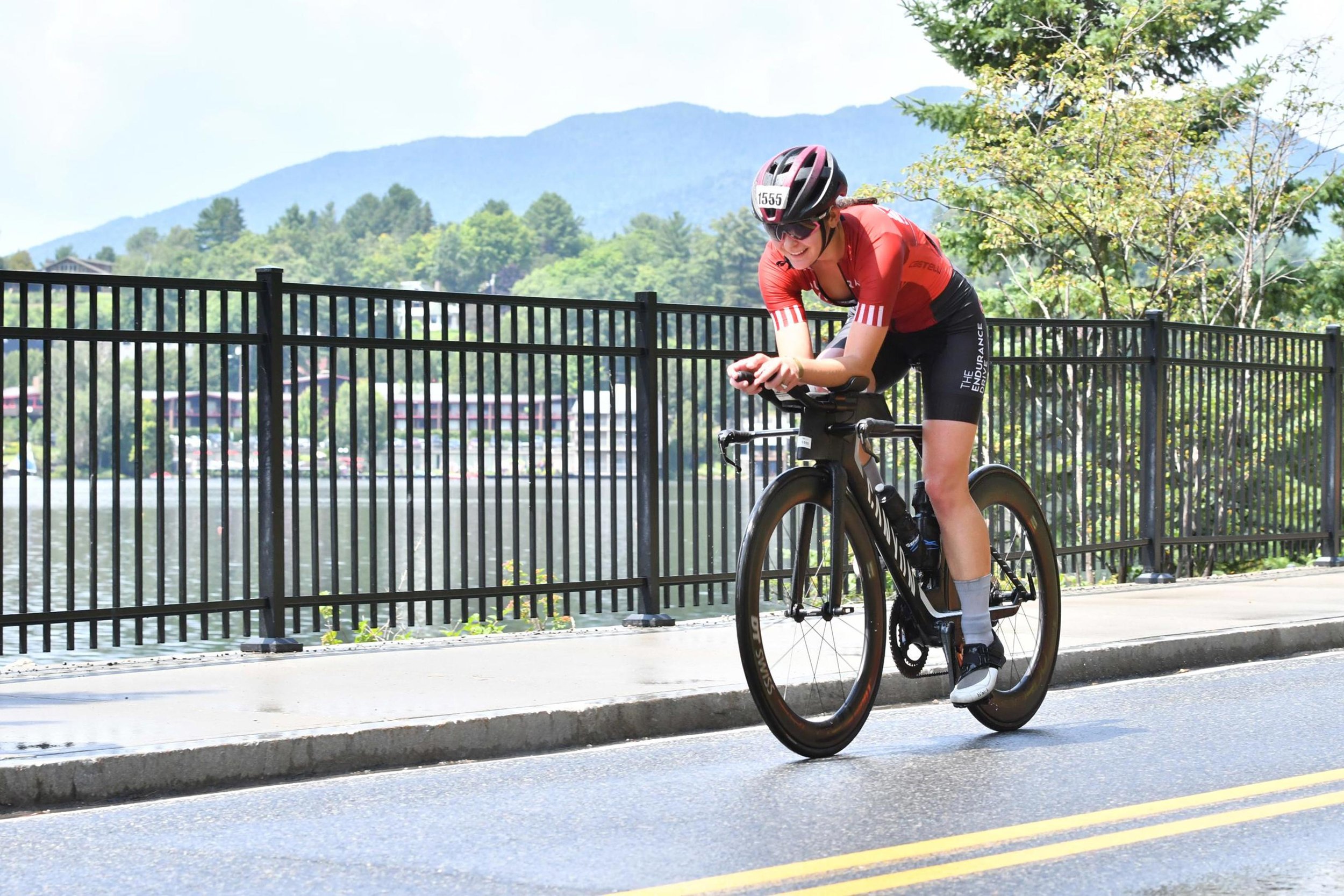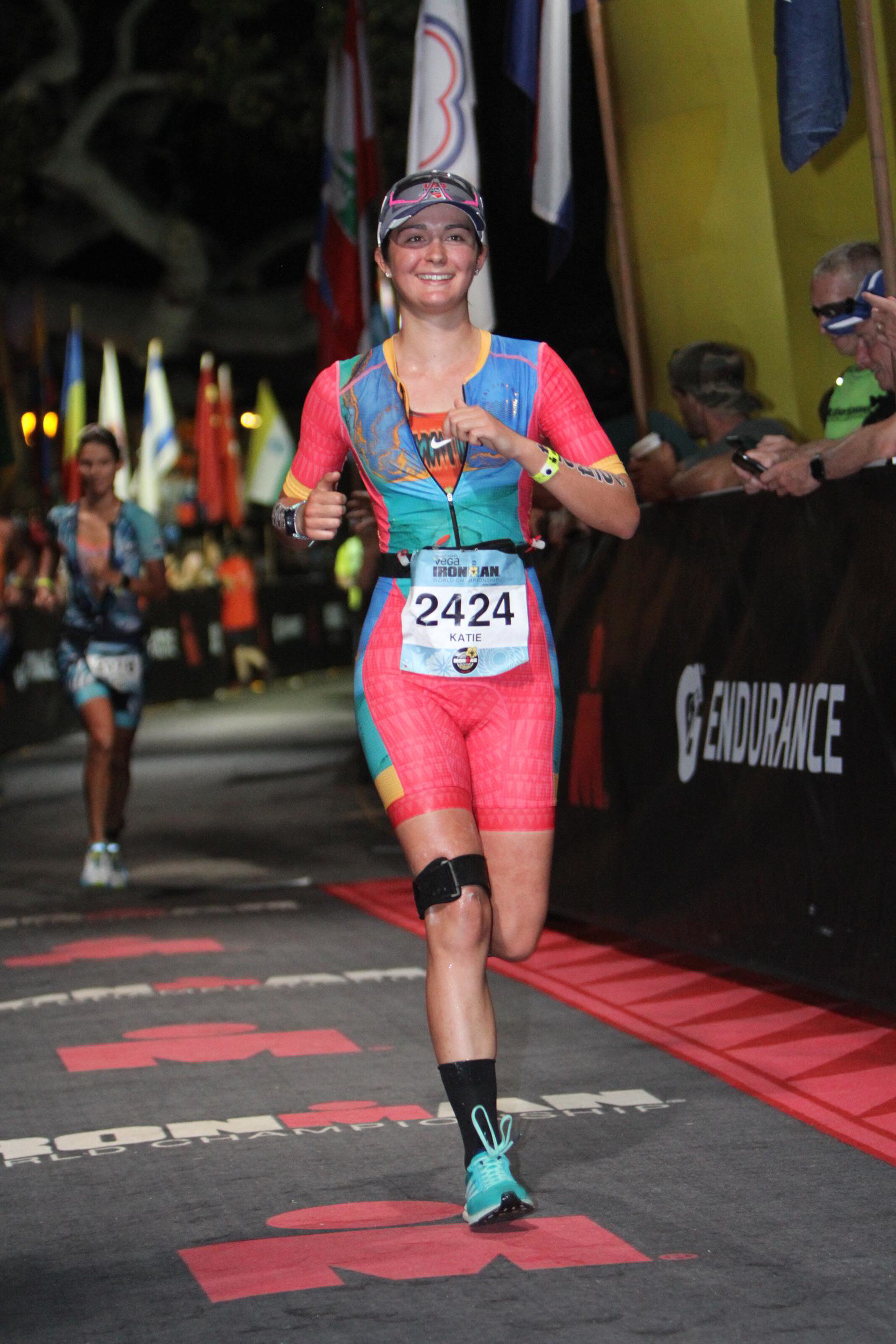This weekend, I raced at the IRONMAN World Championship in Kailua-Kona, Hawaii, after winning my age group and qualifying at IRONMAN Lake Placid in July. Initially, I was hesitant about accepting the Kona slot because I was moving across the country at the beginning of September to start a PhD program in California. To add more challenges, a month before the race I developed IT band syndrome that caused significant knee pain any time I ran more than 3 miles. With all of those factors in play, finishing the race was in doubt.
Kona is famous for its extreme heat, humidity, and winds, so even though the bike and run are slightly less hilly than IRONMAN Lake Placid, the conditions make it one of the toughest courses out there. October is Kona’s hottest month, and the swim is marked by big ocean swells, the bike by headwinds, crosswinds, and sizzling pavement, and the run by unforgiving humidity and sunshine. Most professional triathletes come out to Kona weeks in advance of the race to get acclimated to the heat, but I was busy learning about American political institutions and linear regression in dry and temperate California. I flew out to Kona with Connor the Wednesday before the race, and Jim and my dad met us there soon after.
Jim and I put together a race plan that took into account 1) the environment, 2) my semi-functional knee, and 3) the primary goal of the Kona experience, which was to have fun. Unlike at Lake Placid, there was no pressure to “qualify” for anything, and friends who had raced at Kona before reminded me that the race was just the cherry on top of a great season. We made pacing, fueling, hydration, and staying cool the top priorities. Here’s a summary of what that looked like and how it all went down:
The Swim: 1:16:02
The swim is a 2.4-mile single out-and-back in Kailua Bay. You swim about 100 yards out to some buoys that mark an “imaginary start line” in the water, tread water for a couple of minutes with your group, and then start swimming when the gun goes off (which was at 7:15 am for me). The plan was to take the swim pretty easy, sight as best as possible, and get physically and mentally prepared for the bike.
When the gun went off, it was actually pretty enjoyable. I found some people to draft behind at different points and sighted often, enjoying the tropical fish and coral underwater and the added buoyancy of the salt water. The wave start system meant that there were fewer people around me than there would have been with a mass start. Things got a little more hectic when we rounded the corner and caught up with the slower swimmers in the men’s 55+ age group, but I finished strong and felt good coming out of the water in 1:16:02, which was a little faster than what we had predicted based on my Placid swim time.
T1: 5:40
I quickly stopped at the hoses to rinse off the salt water and then headed to the women’s change tent, which was a zoo. I grabbed my bike bag and got my socks, shoes, helmet, and glasses on. A lot of people were running through transition, but I tried to just walk quickly to avoid aggravating my knee any more than it was going to be aggravated with the marathon. I made it out of there in 5:40 and was onto the bike.
The Bike: 6:14:52
The plan for the bike was to observe a *strict* heart rate cap of 150 bpm. In other words, if my heart rate went above 150, I needed to go easier. This was a pretty low cap, especially compared to my Placid effort, but the problem with Kona is that once your heart rate soars from going out too hard, it’s almost impossible to get it back down. I usually train based on power, but Jim actually told me to ignore power and base the entire bike around heart rate.
I stuck with the plan, and it was actually pretty easy to ignore power because my power meter was flickering on and off for the entire ride. My heart rate was mostly in the high 140s, and I fought to get it back down by easing off the gas any time it went above 150. The course takes you through town on a short loop, then up Palani Hill and onto the “Queen K” highway, where you bike out to mile 60 at Hawi and then back to town for a total of 112 miles. There are several sections of the course that each present different challenges: sometimes it’s intense headwinds or crosswinds, sometimes it’s oppressive heat as you bike by the lava fields, and sometimes it’s steady uphills that are usually accompanied by headwinds.
It was already hot by 8:35 am when I got on the bike, and the day just got hotter. Luckily, there were a couple of clouds that offered brief respite from the heat, and I learned early on that the best way to stay cool was to pick up an ice-cold water bottle at every aid station (approximately every 7 miles), dump the entire contents all over my head and neck, and grab a second one to drink and pour on me until I reached the next aid station. I was also trying to take in as many carbs as I could in the form of Infinit sports drink, a couple of bars, and some shot blocks. The headwinds and crosswinds picked up pretty quickly into the bike and it sometimes felt like I was either not moving forward or going to topple over, but I just stuck to my heart rate plan and ultimately made it to Hawi, where I benefited from a short but awesome tailwind on the downhill leaving the town. I battled a really tough headwind for the last 20 miles coming back into Kona, but I was glad that I had stuck to the heart rate plan and wasn’t feeling totally out of energy. Now it was time to get mentally psyched up for the big wild card: the run!
T2: 8:23
I took my time in T2 to make sure I was comfortable, because I knew there was a good chance I would be spending a long time out there for the run — especially if I had to walk. I changed socks, put on shoes, ate a stroopwafel, stopped by the porta potties, and put on my race belt, visor, and knee strap, which allegedly offers some relief from IT band pain. There were actually several women who were having various degrees of emotional breakdowns in the change tent, so I was pretty happy that I was still in good spirits after my controlled bike ride. I headed out of the tent and was off!
The Run: 4:05:03
The plan for the run was to keep my heart rate below 155, and per my doctor’s orders, “run until you can’t run anymore.” My doctor had said that I couldn’t necessarily make the injury worse by running through it in the race, but I was worried that I would be literally unable to get my leg to respond at all if the pain got really bad. I had never been more uncertain going into a run.
When I started, I actually felt pretty good. My IT band was a little stiff but I had no knee pain, and I was so happy about it that I couldn’t wipe a goofy smile off my face. I smiled all the way through the first 7 miles in town (no pain!) and enjoyed sticking ice and cold sponges down my back and dumping water on my head at every aid station. I took in a couple of gels but ultimately switched to Gatorade and flat coke because they were easier to stomach.
At mile 8 there is a big climb up Palani Hill and onto the Queen K (yes, we have to run and bike there), and that’s where it’s a little harder to keep morale up. The 17 miles on the highway and into the Energy Labs section of the run are very desolate and lonely. There are tons of spectators in town, but almost none on the Queen K. The whistling winds are punctuated by heavy breathing and wet feet pounding the pavement with a squelch.
On the bright side, I was able to run up Palani (still no pain) and continued to feel pretty good. I had to slow down my pace a little to stay under my heart rate cap, but I was doing sub-10 minute miles the whole time and I was so happy to be running for this long pain-free that I didn’t really care about the pace. I felt kind of like a ticking time bomb with a knee that could give out at any given moment, but I knew that the more miles I ran, the fewer I would ultimately have to walk.
As I ran through the Energy Labs, the sun started to set and I was getting tired. My knee was still holding up, though, so I told myself that I needed to keep running until 1) it gave out, 2) my heart rate spiked to a point where I couldn’t get it down, or 3) I literally fell over. None of those things had happened, so I pressed on. By mile 20, the sun had set over the Pacific, and the highway was pitch black. I could see the twinkling lights of the town, though, and the thought of the finish propelled me forward.
When I finally came back down Palani at mile 25, I could hear Mike Reilly’s voice and the roar of the crowds, and I started to get excited because I knew that even if my knee gave out now, I would still be able to walk, crawl, or even roll across the finish line. By some miracle, it continued to cooperate, and I picked up the pace for a smiling sprint down the finish chute. The crowd was roaring, the lights were bright, and as I crossed the finish line I heard those magic words: “Katie Clayton, from Stanford, California…Katie, YOU ARE AN IRONMAN!”
Finish: 11:49:57, 14th in AG, 5th American
The 2019 IRONMAN World Championship was not my fastest race, but it represented my best-ever execution of a race plan. I was enjoying myself for almost the entire time, I ran the whole marathon, and I didn’t end up in the med tent. And hey -- if the advice to “have fun” lands me with 14th in the world and 5th American in my age group, I’d like to think that I have a whole lot more untapped potential that’s just waiting to make its debut. - Coach Katie
Katie Clayton 2019 IRONMAN World Championships - Kona, HI



